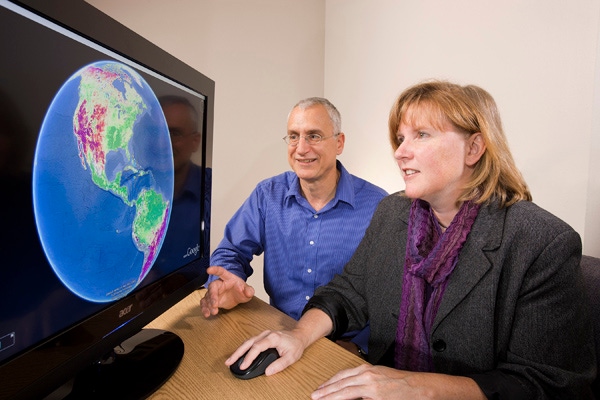Agricultural Research Service (ARS) scientists Martha Anderson and Bill Kustas have developed a modeling system that will help forecasters monitor ET and drought conditions across the United States and overseas.
February 7, 2012

Farmers and water managers may soon have an online tool to help them assess drought and irrigation impacts on water use and crop development, thanks to the work of two U.S. Department of Agriculture (USDA) scientists.
Agricultural Research Service (ARS) scientists Martha Anderson and Bill Kustas have developed an evapotranspiration (ET) and drought modeling system at the ARS Hydrology and Remote Sensing Laboratory in Beltsville, Md. The modeling system also will help forecasters monitor ET and drought conditions across the United States and overseas.
ARS is USDA's principal intramural scientific research agency, and the research supports the USDA priorities of responding to climate change and promoting international food security.
The model, known as ALEXI (Atmosphere-Land Exchange Inverse), uses thermal infrared imagery from satellites and calculates soil and plant temperatures that can be used to create maps of ET rates of plants growing in cultivated areas, forests and natural habitats around the world.
ET consists of the water evaporated from soil and plant surfaces, and the water vapor that escapes, or transpires, through plant leaf pores (stomata) as the plants absorb carbon dioxide through photosynthesis. Generally, evaporation cools surfaces, so a cooler land surface is an indicator of higher ET rates and wetter soils.
Water stress elevates soil and leaf temperatures, which can be detected by satellites. Anderson and Kustas can use satellite temperature data to create ET maps. The maps are capable of detecting rivers, lakes, wetlands, riparian buffers, irrigated cropland and areas under water stress.
The work is funded by the National Oceanic and Atmospheric Administration (NOAA) and the National Aeronautics and Space Administration (NASA). NOAA plans to use the system to generate ET estimates over the continental United States. The system is expected to become particularly relevant as climate change presents challenges for growers and water managers in areas such as the Texas Panhandle, the Florida Everglades and the southwestern United States.
Getting routine ET estimates for individual fields is laborious, but the researchers are streamlining the process. With help from new satellite imagery, they hope to be able to move toward routine mapping at the "field scale" level. ALEXI has been estimating evapotranspiration (ET) rates since 2000, but the researchers continue to refine the system and plan to make the maps available online soon on the U.S. Drought Portal at www.drought.gov.
Anderson and Kustas, with colleagues, are currently mapping parts of Africa, including the Horn of Africa, where drought has caused famine in Somalia. Local ET data would be particularly helpful in places such as Africa, where networks of weather stations don't exist.
Read more about this research in the February 2012 issue of Agricultural Research magazine.
You May Also Like



